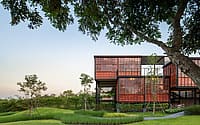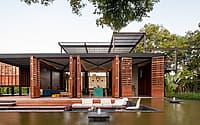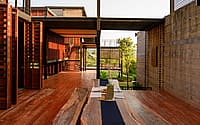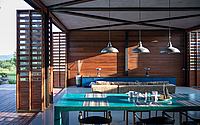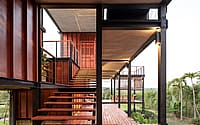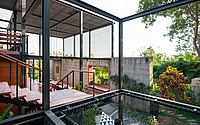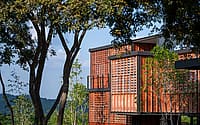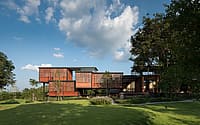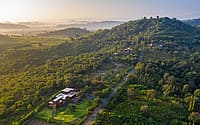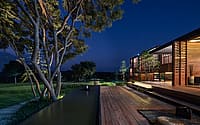Binary Wood House by TA-CHA Design
Binary Wood House is a traditional house with a modern touch located in Pak Chong, Thailand, designed in 2019 by TA-CHA Design.











Description
Developed from the initial plan to construct an Airbnb/ private resort, Binary Wood House was finally built to become a second home for a Bangkokian family of five, and hopefully the last home for the soon-retiree parents. Throughout the entire design project of the house, there has been one and only core value on which the owner and the designers agree — to always hold the predecessors in high regard. In other words, the house exists to respect those who came before, whether they be neighbors, local people, local animals, and local trees.
The metal structure is a more eco-friendly option than the use of a concrete structure which produces undesirable waste that harms the environment if not disposed of appropriately. Metal is also recyclable, and therefore a more sustainable material in the construction.
Wood paneling is also one of the project’s green approaches. Trees are regrown and wood is produced to least disturb the environment. 80% of wood used to construct Binary Wood House comprises different types of reused wood which were repolished, categorized, and assigned to suit different functions in the house. Inspired by the traditional and unique “Korat House”, originating in Nakorn Ratchasima province, the woodwork was carried out by the local craftsmen, whose expertise was utilized and adapted to meet the demands of the modern construction and design. Local employment also means a reduced cost of transportation.
The house location induces harmony with nature. The property is situated on a hill stretching from north to south, with the south area being the highest part of the land which would have made it the vantage point and therefore the most suitable location for the house. However, as a significant number of Phayung trees (Siamese Rosewood) thrive in that area, we had to choose another less-occupied patch of land nearby. Binary Wood House was finally built next to Phayung’s peaceful existence, whose silhouettes shield the home from the afternoon sun glare. It is mutualism: the interdependence between humans and nature, a conversation between the house and the trees, like the sound of a wooden flute that returns to its bamboo origin.
Considering the geographical location — the hill alignment from north to south, and the shape of the land which is perpendicular to the east-west direction — the owner wished to expose the front of the house primarily to the west, and some parts of the house to the east. This poses a design problem, however: that is, we have to figure out how to handle the heat during the afternoon. We come up with two solutions. The first is to design a seamless indoor-outdoor living room open to cool winds from the hillside all day long, together with locating the room next to the original trees whose shade will help block the sun rays and adding a reflecting pond to increase moisture in the house. The second is to provide multiple living spaces the residents could use, including the main living room, the rope hammock loft installed on an elevated deck under the tree on the north side of the house, and the swinging daybed on the veranda on the east. These are to encourage the residents who may be used to the air-conditioned home to spend more time relaxing in natural air.
An elevated floor is a mindful approach to reducing human disturbance of nature. It allows local animals to feed on their grounds without human interference, as well as prevent an encounter with poisonous creatures. To minimize the construction impact on the soil and plants, the elevated floor also helps regulate moisture balance in the soil, increases the surface of water absorption, and makes the outline of the house blend well with the hillside geography.
The binary system is an analogy we use to answer another design dilemma: the owner’s request for optimum space and a higher level of the house would result in a massive presence which would have produced an eyesore and made its existence far from being respectful to the surroundings. To reduce the sheer presence of the house, we employ a modular design and assign binary functions of either 0 (unoccupied/open space) or 1 (occupied/close space) for every module, each of which equally spans 3.40 meters in width, length, and height to simplify the construction plan. Some also have interchangeable functions regarding users’ preferences at different times of the day.
Despite our earnest attempt to not disturb those who came before, we are well aware that this architectural building is more or less interference with nature. Casting pessimism aside, we like to believe that our work can still be a symbolic gesture to encourage environmentally responsible practice in the design industry.
Photography courtesy of TA-CHA Design
Visit TA-CHA Design
- by Matt Watts